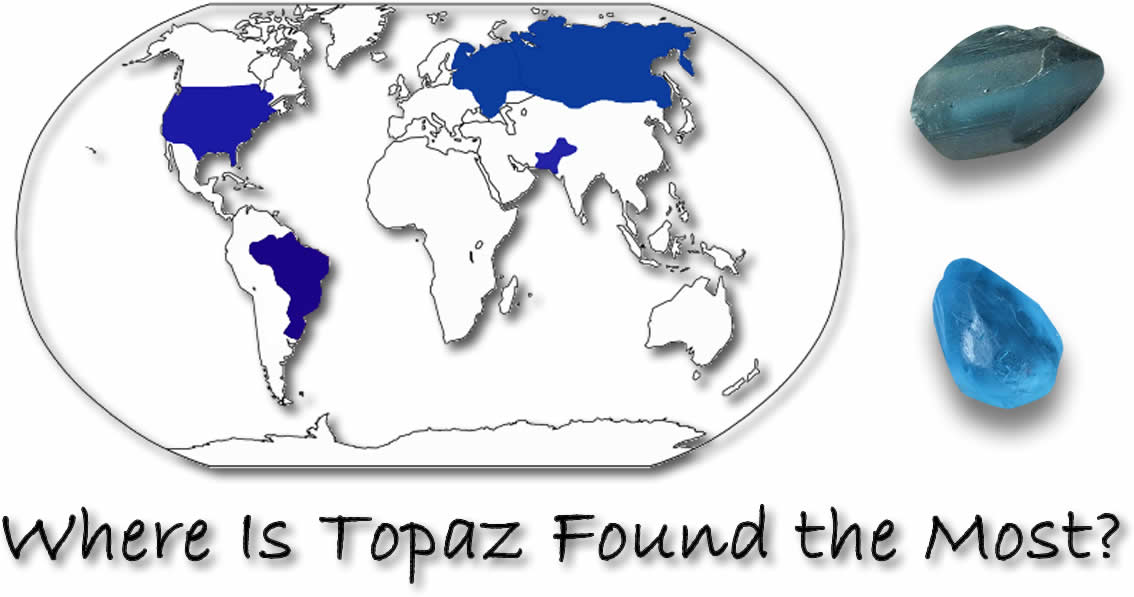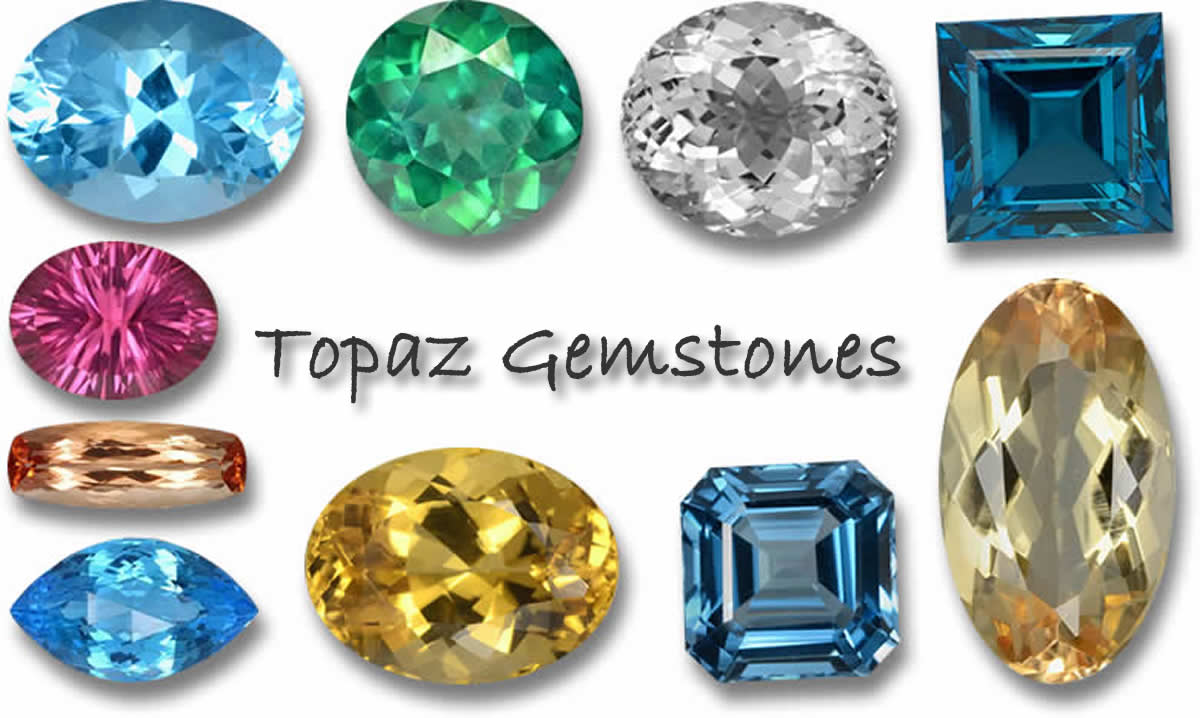Where Is Topaz Found the Most - Exploring Top Locations
 Shop Topaz Gemstones from different Locations
Shop Topaz Gemstones from different LocationsTopaz stands out as a stunning gemstone, valued for its vibrant colors and impressive clarity. It's a go-to choice for jewelers and collectors. This gem comes in shades like golden yellow, blue, pink, and even colorless. But topaz isn't scattered everywhere—specific spots around the world are famous for their abundant deposits and top-notch quality. In this piece, we'll dive into the prime locations where topaz is most commonly found, looking at the geology, mining methods, and historical importance of each area. Let's uncover those top topaz hotspots worldwide.
Key Takeaways
- Topaz appears in various spots globally, with Brazil, the United States, Pakistan, and Russia leading as key producers.
- Grasping the geological roots of topaz deposits is vital for finding and extracting this gem.
- Topaz mining brings its own set of hurdles, like reaching remote areas and promoting eco-friendly practices.
- The worldwide topaz trade features a detailed supply chain, from mining to market shelves.
- Topaz has always been seen as a rare and valuable gem, appealing to investors and collectors.
Topaz: A Gemstone of Rarity and Beauty
Topaz is an impressive semi-precious gem that draws attention with its clear shine, toughness, and wide range of colors. This mineral is a silicate made up of aluminum and fluorine, following the formula Al2SiO4(F,OH)2. That makeup gives topaz its standout traits, like a hardness rating of 8 on the Mohs scale and the capacity to show colors from classic golden-yellow to blues, pinks, and clear types.
What Is Topaz?
Topaz is a gemstone treasured over centuries for its natural appeal and strength. Its resistance to scratches and damage makes it ideal for jewelry, decor, and collectibles. Experts in geology and gems have long studied the properties of topaz that create its distinctive charm.
The Variety of Topaz Colors
What makes topaz so appealing is its broad palette of colors, spanning warm golds to cool blues and pinks. This diversity stems from its composition and how it plays with light. Hey, imagine picking from such a spectrum—each shade brings its own vibe, which is why designers and fans love it.
 Loose Topaz Gemstones in all Colors
Loose Topaz Gemstones in all ColorsGeological Formation of Topaz Deposits
Topaz forms through a mix of geological activities and conditions. Knowing how these deposits come about is key to finding and mining the stone. We'll break down the three main settings: origins in igneous rocks, formations in metamorphic, and environments in sedimentary rocks.
Igneous Rock Origins
Most topaz comes from igneous sources like granites and rhyolites. Here, it can form as magma cools or through hydrothermal fluids mixing with rock. The rock's makeup and cooling process affect the deposit's development and grade.
Metamorphic Rock Formations
Topaz can emerge in metamorphic settings, where extreme heat and pressure reshape minerals. This transformation can produce topaz as the rock's chemistry shifts. The mineral setup and metamorphism intensity shape the topaz's features and worth.
Sedimentary Rock Environments
Sometimes, topaz shows up in sedimentary layers, transported there over time. These come from erosion freeing topaz from original sources, concentrating it in sediments. Figuring out the geological past of these areas is crucial for extraction.
Exploring topaz's varied origins helps us value the intricate processes behind this gem. This insight supports effective exploration, mining, and management of topaz resources everywhere.
Major Topaz Mining Regions Around the World
As we get into topaz, checking out the main areas where this gemstone is found in plenty is essential. From top producers to new zones, this gives us the scoop on topaz's spread and supply.
Brazil: The Global Leader
Brazil dominates topaz output, with big deposits in Minas Gerais and Goiás. Its rich geology and mining setup have made it as the main supplier for jewelry, collections, and industry.
United States: Rich in Topaz Variety
The US offers a wide mix of topaz, with key spots in Utah, California, and Colorado. From golden tones to rare blues, American deposits provide options for gem fans and the trade.
Pakistan and Russia: Emerging Hotspots
New areas are gaining notice, like Pakistan's blue topaz that excites collectors. Russia is ramping up mining too, hinting more potential in the area.
Knowing topaz's geographic spread helps us see the global availability and special qualities. From Brazil's top spot to US variety, and rising areas in Pakistan and Russia, these regions keep amazing those who value this gem.
 Topaz Gemstones from important Topaz Locations
Topaz Gemstones from important Topaz LocationsWhere Is Topaz Found the Most?
For topaz distribution, some places lead as top sources. Brazil tops as the producer, with vast deposits in Minas Gerais and Goiás. The US has strong presence, like in Utah, California, and Colorado.
Rising spots include Pakistan for blue topaz and Russia with growing mining. Exploring these gives a full view of where this gem is most plentiful.
Here's a closer view in this table:
| Country | Topaz Production | Key Topaz Deposits |
|---|---|---|
| Brazil | Global Leader | Minas Gerais, Goiás |
| United States | Significant Presence | Utah, California, Colorado |
| Pakistan | Emerging Hotspot | Blue Topaz Deposits |
| Russia | Increasing Topaz Mining | Various Regions |
Understanding topaz deposits and locations helps appreciate the supply and traits of this gem.
Topaz Mining Techniques and Challenges
Getting topaz out requires varied methods, from old-school manual to advanced. In some spots, artisans dig and sift alluvial areas for gems. Larger ops use modern gear to find and extract from igneous or metamorphic sources.
Traditional Mining Methods
For ages, topaz has been mined manually by artisans. They excavate alluvial deposits where crystals gather, using sifting. Their knowledge of local geology and practices is key.
Modern Extraction Processes
As demand rises, mining adopts tech. Ops use heavy machinery, drills, and remote sensing to access deposits. This helps meet needs while tackling topaz mining challenges.
Challenges include remote access, safety, sustainability, and supply logistics. Understanding techniques shows the industry's work to overcome them and supply globally.
The Global Topaz Trade
The trade links suppliers, wholesalers, and retailers, from producers to users in jewelry and more. From Brazil, US, Pakistan, Russia to markets, it's a showcase of global expertise.
| Top Topaz Producing Countries | Primary Topaz Varieties | Key Topaz Trade Hubs |
|---|---|---|
| Brazil | Golden-yellow, pink, blue | São Paulo, Rio de Janeiro |
| United States | Colorless, pale blue, pink | New York, Los Angeles |
| Pakistan | Vibrant blue | Peshawar, Islamabad |
| Russia | Golden-yellow, brown, colorless | Moscow, Saint Petersburg |
The Future of Topaz: Exploring New Frontiers
With rising demand, the industry seeks new areas for topaz. Geologists use advanced tools to find emerging deposits.
Emerging Topaz Deposits
For the future, experts hunt untapped deposits with satellite and surveys. New finds could grow supply and bring opportunities.
| Emerging Topaz Deposits | Technological Advancements in Mining |
|---|---|
|
|
Conclusion
Wrapping up, our look at topaz mining regions tells the story of this gem. Knowing where it's most found helps navigate the market and value its path from mine to final product. The industry's focus on tech and sustainability signals a promising road ahead.
Looking forward, the topaz sector is set to fulfill demands responsibly. Our overview provides takeaways for appreciating topaz long-term.
Frequently Asked Questions
Where is topaz found the most?
Topaz is found primarily in regions around the world, with Brazil as the global leader in topaz production. Major deposits are located in the Brazilian states of Minas Gerais and Goiás. The United States also has notable sources of topaz, particularly in Utah, California, and Colorado. Emerging hotspots include Pakistan, known for its striking blue topaz, and Russia, where topaz mining has been on the rise in recent years.
What is the geological formation of topaz deposits?
Topaz is formed through complex geological processes involving various rock types and environmental conditions. The most common sources of topaz are igneous rocks, such as granites and rhyolites, where the mineral can crystallize from magma or hydrothermal fluids. Topaz can also form in metamorphic rock environments, where intense heat and pressure transform existing minerals into new ones, including topaz. In some cases, topaz can be found in sedimentary rock formations, where it has been transported and deposited over time.
What are the major topaz-producing regions around the world?
The world's leading topaz producer is Brazil, with significant deposits located in the states of Minas Gerais and Goiás. The United States also boasts a rich diversity of topaz varieties, with notable sources in Utah, California, and Colorado. Emerging topaz hotspots include Pakistan, where stunning blue topaz is found, and Russia, which has seen an increase in topaz mining in recent years.
What are the mining techniques used to extract topaz?
Topaz mining employs both traditional and modern extraction methods. In some regions, artisanal miners use manual techniques, such as digging and sifting through alluvial deposits, to uncover topaz gems. In larger-scale operations, advanced machinery and technology are utilized to efficiently locate and extract the mineral from primary sources, including igneous and metamorphic rock formations. However, topaz mining often presents unique challenges, such as accessing remote or difficult-to-reach deposits and ensuring the safety and environmental sustainability of mining practices.
What are the environmental considerations in topaz mining?
The mining of topaz can have significant environmental implications, including concerns around habitat destruction, water pollution, and soil degradation. In response, leading topaz producers are increasingly adopting eco-friendly mining techniques, such as implementing water recycling systems, restoring mined areas, and minimizing the use of hazardous chemicals. There is also a growing emphasis on ethical sourcing, ensuring that topaz is obtained through transparent and socially responsible means. By addressing the environmental impact of topaz mining, the industry aims to strike a balance between meeting the global demand for this gemstone and preserving the natural ecosystems in which it is found.
How does the global topaz trade work?
The journey of topaz from the mine to the market involves various stages of processing and distribution. After the initial extraction, topaz crystals undergo meticulous sorting, cleaning, and cutting to enhance their natural beauty and value. Skilled gemstone cutters and polishers transform the rough stones into the dazzling faceted gems we admire in jewelry and decorative pieces. The global topaz trade encompasses a network of suppliers, wholesalers, and retailers, connecting the world's top producing regions with consumers in the jewelry, collector, and industrial sectors.
What factors affect the value of topaz?
The value of topaz is influenced by a variety of factors, including its color, clarity, carat weight, and the overall demand for the gemstone in the market. Certain varieties, such as the coveted blue topaz, can command higher prices due to their scarcity and desirability. Additionally, the overall condition and provenance of a topaz specimen can also affect its perceived worth. By understanding the key drivers of topaz value, investors and enthusiasts can make informed decisions when acquiring or trading this captivating gemstone.
What is the future outlook for the topaz industry?
As the global demand for topaz continues to grow, the industry is exploring new frontiers to uncover and extract this valuable gemstone. Geologists and mining companies are actively searching for emerging topaz deposits in underexplored regions, leveraging advanced exploration techniques and geological data to identify promising sources. Additionally, the industry is embracing technological advancements to enhance the efficiency and sustainability of topaz mining operations, from automated extraction processes to the utilization of drones and satellite imagery. By staying at the forefront of these developments, the topaz industry is poised to meet the evolving needs of consumers and investors while minimizing the environmental impact of its activities.

